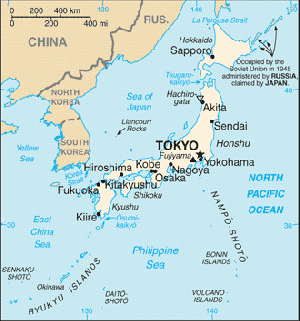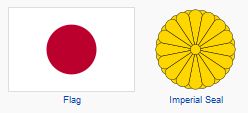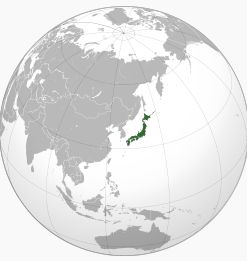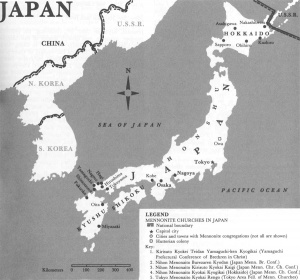Japan



Japan proper is composed of an archipelago of four main islands and hundreds of smaller ones. Honshu, the largest and centrally located, is also culturally and economically the center of the country. Tokyo, ranking third in world population, is located centrally in this island, and is the very heat of Japan. To the south of Honshu lie the larger island of Kyushu and the smaller Shikoku. These two islands and the southern two thirds of Honshu are caressed by the warm Kuroshio currents from the south, making these areas subtropical in climate. Intense tropical typhoons sweep up from the south and lash these areas in late summer and early fall, often bringing intense suffering and destruction from strong winds, floods, and tidal waves. Hokkaido lies far to the north, separated from the main island by the Tsugatu Straits. Hokkaido's shores are swept by the chill currents originating in the Arctic, and its prevailing winds are northwesterly, sweeping down across the vast Siberian and North Manchurian plains, so that climate in Japan varies more than her 1300 miles from north to south would indicate.
Into this archipelago, comprising only 147,707 square miles (a little less than the state of California) and lying just off the coast of the Asiatic mainland, were crowded over 80 million people in 1955. In 1955, farming was the main occupation, and as the country is extremely mountainous, having only 17 per cent of the country being arable, farm land was at a premium and farms were of necessity small, varying from 3/4 of an acre in the south to as high as 40 acres in the then newly settled northern island of Hokkaido. Though rich in gold, copper, and sulphur, Japan lacked (at that time) the basic natural resources for modern heavy industry, and so found her (circa 1955) economic life dependent largely on the often not too considerate whims of the western world.
Japanese history loses itself in old, pre-historical legend. Jimmu Tenno, the semi-historical founder and first emperor of the Japanese nation, supposedly lived about 600 B.C. He is said to have been a direct descendant of the sun-goddess, and the direct ancestor of a long line of two and one-half centuries of emperors, culminating in the 20th century's Emperor Hirohito. The Japanese are proud of this old history, and much of the religio-patriotic fervor that made possible the recent and terrible Pacific conflict grew out of this semi-mythology.
The Mennonite witness to this ancient land is not old. Though modern Protestant missions in Japan was 100 years old in the mid-20th century, the Mennonite participation began only in 1949. After an exploratory trip by J. N. Byler, the MCC sent its first workers, Henry and Lydia Thielman, to Japan in April of 1949. With the help of Ruth and Rhoda Ressler, who arrived later in the same summer, a relief and rehabilitation work was established in the completely devastated Konohana-ku section of the city of Osaka. In December of the same year the Mennonite Board of Missions and Charities (Mennonite Church) sent two missionary families to Japan, the Carl Becks and the Ralph Buckwalters. A year later, in August 1950, the Mennonite Brethren Church sent their first missionary, Miss Ruth Wiens. Later that same winter the General Conference Mennonite Church's first representative, Miss Lenore Friesen, arrived also to begin language study. In the summer of 1953 the Brethren in Christ Church sent their pioneer couple, Peter and Mary Willems, to Japan.
These four groups have worked independently, yet with a very close sense of fellowship and cooperation. The Mennonite Church missionaries went to the northernmost, neglected island of Hokkaido, General Conference missionaries to the southernmost tip of the southern island of Kyushu, the Brethren in Christ to the Yamaguchi prefecture in the southwestern part of the main island of Honshu, and the Mennonite Brethren group stayed in and around the city of Osaka, where they absorbed the plant and program of Mennonite Central Committee (MCC) in that city. The MCC has moved to Tokyo, where it hopes to become more active in a direct peace witness and in literature production, and where it has the Norman Wingerts and the Melvin Gingerichs as workers.
American personnel in 1955 in Japan numbered as follows: Mennonite Church 17, General Conference Mennonite 18, Mennonite Brethren 12, and Brethren in Christ 2. A Mennonite church has arisen from the native soil of Japan which numbered approximately 250 active members in 1955. Though many of these were young in years and all of them were young in Christian experience and came out of a religious culture foreign to Christianity, many of them seemed willing and anxious to give themselves to the work of the church. Almost the entire burden of the Sunday schools was borne by the national church. Home and hospital visitation, street evangelism, Bible study, summer Bible camp, winter Bible school, village tent evangelism, personal witnessing, and a variety of other activities depended largely on this young church for personnel and support. A number of young men from the various missions were, in 1955, away in Bible schools and seminaries in preparation for giving a fuller ministry to their local congregations. -- Carl C. Beck
1987 Update
Japan is an island country located just off the continent of Asia. Four main islands make up the archipelago: Honshu, Hokkaido, Kyushu, and Shikoku. Land area totals 377,708 sq. km. (145,800 sq. mi.). It is slightly smaller than California, extending about 2,500 km. (1500 mi.), approximately the distance from s. Italy to Denmark or from Buenos Aires to Cape Horn.
The population is 127,417,244 (1986 est.). Density is 337 persons per sq. km. (874 per sq. mi.), and, since Japan's land surface is four-fifths mountainous, this is probably the highest population density in the world.
For administrative purposes the country is divided into 47 prefectures (counties). Government is a constitutional democracy, with the emperor but a figurehead. The Diet (Parliament) is in Tokyo.
The ancient history of Japan, also known as "Nihon" or "Nippon" ("origin of the sun"), is shrouded in mythology. But competing clans were unified under the Yamato Dynasty (3rd-8th centuries A.D.), centering in the emperor. Imperial courts then flourished in succession to the end of the 12th century. After that a feudal system of military rule prevailed until the Meiji Restoration in 1868.
By the early 20th century, Japan had shifted from an agrarian to an industrial society. In spite of wars between China and Japan (1930s) and Russia and Japan (1904-1905), and despite the devastation of World War II, the country reconstructed itself and became once more a major economic power.
Japanese culture is largely based on Buddhism and Confucianism, brought in from China and Korea during the 6th century. Shintoism, native, and at one time the state religion, also has had a pervasive influence.
Christianity did not arrive until 1549, via Francis Xavier, a Roman Catholic missionary. By the early 1600s there were about 300,000 Christians in Japan. But feeling threatened, the Japanese feudal government decided to close itself off to western countries. Thus Christianity was also banned. Japan remained isolated from the rest of the world for over 200 years, until forced open by U.S. military pressure (1853) to trade with the West. The policy then became, "from Asian to Western."
From 1858, Protestants also began evangelistic efforts. Progress was not rapid. Although, in 1986, freedom of religion is guaranteed by the constitution, membership in both Catholic and Protestant churches exceeds no more than about 1.1 percent of the entire population. The impact of Christians however far outweighs mere numbers. Kanzo Uchimura and Toyohiko Kagawa are names from the past familiar to most, and Miura Ayako and Shusaku Endo from the present. Many educators and even some prime ministers have been Christian.
For several reasons Christianity's progress has been slow. First, wanting to be independent of western colonialism Japanese had great interest in modern technology, but not in western religion. Second, Japan had a long history of Shintoism, Confucianism, and Buddhism before Christianity came. Third, having been forbidden at one time, Christianity still carries a stigma of "foreignness." Fourth, many Japanese misunderstood this new religion as western cultural ethics, rather than "good news," and as individualistic in nature, making it hard to build community, a prime value in Japanese culture.
In modern times prosperity and materialism are obstacles. The image of the church has been tarnished in other ways as well. Most Japanese churches gave in to nationalism and the war and had little vision afterwards.
Mennonites have been working in Japan since about 1950, in the Tokyo (General Conference Mennonite, Mennonite Church), Hokkaido (Mennonite Church), Osaka (Mennonite Brethren ), Yamaguchi (Brethren in Christ) and Miyazaki (General Conference Mennonite) areas. Unlike other Protestant and Catholic groups, they had no experience of suppression as in the closed Edo Period (17th- to mid-19th centuries) and during World War II. It is difficult for so-called "peace churches" to make a "peace witness" during a peaceful era, although Mennonite Central Committee did have a Peace Section representative in Japan during the 1960s.
Article nine of the Japanese Constitution forbids Japan from having military forces. This has been interpreted so as to permit a Self-Defense Force. Nationalism has also been gaining strength in the 1980s. The government, for instance, wants to nationalize Yasukuni Shrine (Shinto) for the war dead. Military expenditures are rising. There is danger that the country might alter its stance against nuclear weapons.
There are a few military tax resisters. Almost none of the churches, Protestant or Catholic, have a peace theology. Mennonites need to reflect on their course, past and future, if they are to be faithful in the present, and fulfill the vision of being "neither Catholic nor Protestant." -- Takanobu Tojo
See also Nihon Kirisutokyo Keiteidan; Nihon Menonaito Burezaren Kyodan; Nihon Menonaito Kirisutokyo Kyokai Kaigi; Nihon Menonaito Kirisuto Kyokai Kyogikai; Nihon Menonaito Senkyokai; Tokyo Chiku Menonaito Kyokai Rengo; Osaka Prefecture; Miyazaki Prefecture; Hokkaido; Yamaguchi Prefecture; Work Camps.
2010 Update
In 2009 the following Anabaptist denominations were present in Japan:
| Denomination | Congregations in 2009 |
Members in 2009 |
Congregations in 2020 |
Members in 2020 |
|---|---|---|---|---|
| Nihon Menonaito Burezaren Kyodan (Japan Mennonite Brethren Conference) | 28 | 1,810 | 27 | 1,774 |
| Nihon Kirisuto Keiteidan (Japan Brethren in Christ Church) | 6 | 231 | 7 | 118 |
| Nihon Menonaito Kirisuto Kyokai Kyogikai (Japan Mennonite Christian Church Conference) | 18 | 442 | 13 | 270 |
| Nihon Menonaito Kirisuto Kyokaikaigi | 14 | 386 | 16 | 370 |
| Tokyo Chiku Menonaito Kyokai Rengo (Tokyo Area Fellowship of Mennonite Churches) | 5 | 98 | 5 | 96 |
| Total | 2,967 | 70 | 2,628 |
Source: Mennonite World Conference. "Mennonite and Brethren in Christ Churches Worldwide, 2009: Asia & Pacific." 2010. Web. 26 October 2010. [broken link].
Bibliography
"Japan." Kodansha Encyclopedia of Japan, vol. 4. Tokyo: Kodansha, 1983: 2-9.
Kraybill, Paul N., ed. Mennonite World Handbook. Lombard, IL: Mennonite World Conference, 1978: 157-177.
Mennonite World Conference. "Global Map: Japan." Mennonite World Conference. Web. 1 April 2021. https://mwc-cmm.org/global-map.
Mennonite World Handbook Supplement. Strasbourg, France, and Lombard, IL: Mennonite World Conference, 1984: 35-39.
| Author(s) | Carl C. Beck |
|---|---|
| Takanobu Tojo | |
| Date Published | October 2010 |
Cite This Article
MLA style
Beck, Carl C. and Takanobu Tojo. "Japan." Global Anabaptist Mennonite Encyclopedia Online. October 2010. Web. 22 Nov 2024. https://gameo.org/index.php?title=Japan&oldid=171053.
APA style
Beck, Carl C. and Takanobu Tojo. (October 2010). Japan. Global Anabaptist Mennonite Encyclopedia Online. Retrieved 22 November 2024, from https://gameo.org/index.php?title=Japan&oldid=171053.
Adapted by permission of Herald Press, Harrisonburg, Virginia, from Mennonite Encyclopedia, Vol. 3, pp. 96-98; v. 5, pp. 464-465. All rights reserved.
©1996-2024 by the Global Anabaptist Mennonite Encyclopedia Online. All rights reserved.

